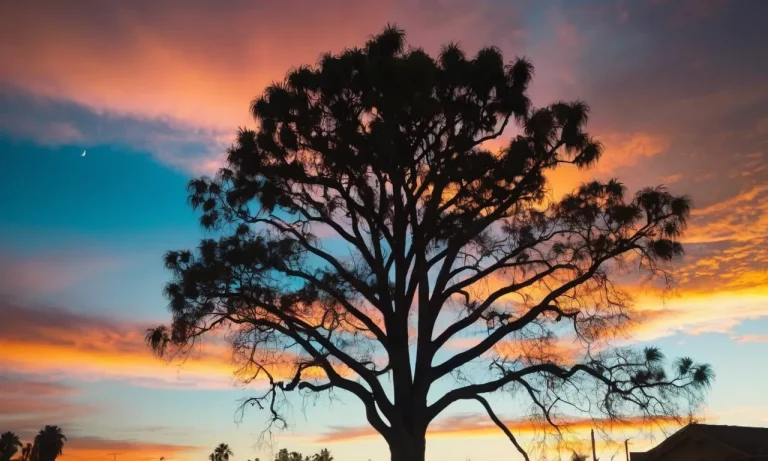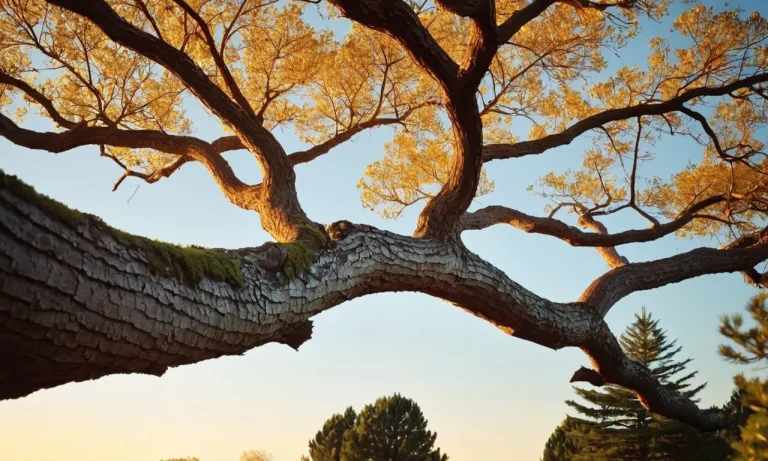The weeping willow is a graceful tree with trailing branches that sway gently in the breeze. With its sorrowful appearance, the weeping willow has deeply rooted symbolic meanings related to emotion, love, healing, and femininity throughout various cultures and spiritual traditions.
If you’re short on time, here’s a quick answer: The weeping willow tree has profound spiritual symbolism related to grief, sadness, healing, everlasting love, growth, flexibility, femininity, and the connection between heaven and earth.
In this comprehensive guide, we will explore the extensive symbolic meanings behind the mystical weeping willow tree, its significance in various spiritual traditions and cultures, poetic references, and how you can apply weeping willow tree symbolism to your own spiritual journey.
What Does a Weeping Willow Tree Symbolize?
Grief, Mourning, and Remembrance
The drooping branches and leaves of the weeping willow give it the appearance of grieving, which is why it has long been a symbol associated with mourning a loss or death. It is often planted in cemeteries as a living memorial to signify enduring love and remembrance even beyond death.
Its leafy branches sweeping to the ground evoke sadness and tears, giving comfort to those grieving the loss of someone dear.
Healing and Rebirth
Yet as spring comes each year, the weeping willow transforms. Tiny green buds appear, soon bursting into delicate leaves and tiny flowers. This renewal every spring symbolizes the tree’s ability to regenerate and heal.
The weeping willow reminds us that rebirth can follow grief – there is light beyond darkness and hope to be found, even in the depths of pain.
Eternal Love
An ancient Chinese legend states that a weeping willow grew from the grave of two lovers, its long trailing branches and leaves forever mournful over their loss. The willow became seen as a symbol of never-ending love, as it constantly grieves for those two soulmates.
Feminine Spirit and the Divine Feminine
The flexible branches which blow gently in the wind evoke the flowing spirit of the divine feminine. Willow trees follow the path of least resistance as they sway – they embody the yielding side of nature, adapting well to change.
For this reason, in Celtic symbolism the willow came to symbolize female qualities and spirits.
Connection Between Heaven and Earth
With their tall height and long dangling leaves, weeping willow trees also emphasize the connection between heaven and earth. They remind us to stay grounded, yet reach for the light. Celtic Druids believed willow trees had access to the world of the spirits and the Divine through their extensive root systems.
Yet their high branches reached upwards towards the heavens and sky.
Flexibility and Going With the Flow
The weeping willow has come to symbolize flexibility and going with the flow of life. Rather than resisting change, the willow adapts. Their branches demonstrate the strength and beauty that comes from bending rather than breaking when faced with challenges.
The Native American medicine wheel associates the willow tree with the west direction, which represents our capacity to explore emotions and go deeper within the self.
Weeping Willow Tree Meanings in Different Cultures
Chinese and Japanese Traditions
In Chinese tradition, the drooping branches of the weeping willow represent friendship and love that lasts through time. Willow trees are also seen as a symbol of longevity and vitality in Chinese culture.
There is an ancient Chinese proverb: “The willow branch in the wind will survive, while the mighty oak may fall. “ This refers to the willow’s ability to bend instead of break, symbolizing flexibility and endurance.
Similarly in Japan, willow trees represent flexibility, love, femininity and grace. During the spring Hanami festival, when the cherry blossoms bloom, Japanese poets have compared willow branches swaying in the breeze to dancing women. Willows are also a symbol of renewal and new growth in Japan.
Celtic Mythology
In Celtic mythology, willow trees were considered sacred and associated with the cycles of life and death. Willow bark contains salicin, a natural form of aspirin, so willow was used as a remedy for aches and fever.
Celtic poets imagined that the gods resided in willow trees, and willow wood was used to make harps and other mystical instruments.
The willow is also linked to water and the moon in Celtic tradition, as it often grows by streams and rivers. The flexible branches evoked the waxing and waning cycles of the moon. Willow wands were also used in rituals and magical charms to connect with spirits and fairy realms.
Christianity
In the Old Testament Bible, exiled Jews in Babylon are described as hanging up their harps upon the willows by the river (Psalm 137). This image of weeping willows symbolized grief, mourning and loss.
Later in Christian tradition, the pliable wood of willow trees was used to create Palm Sunday’s palm branches, which symbolize both celebration and mourning. The branches acknowledge Jesus’s triumphant entry into Jerusalem, while foreshadowing his crucifixion and death.
Greek and Roman Mythology
In Greek legend, willow trees grew by the river that the unlucky Orpheus descended to the underworld in search of his lost love Eurydice. The drooping willow became a symbol of unending heartbreak and grief when Orpheus was unable to bring Eurydice back to life.
The poet Virgil later wrote about how Orpheus carried a willow branch as a wand to charm spirits with his music and poetry. Roman poets imagined willow nymphs wandering riverbanks, representing feminine grace and the life essence flowing through nature.
The Weeping Willow in Poetry and Literature
Works That Feature the Weeping Willow Tree
The graceful, cascading branches of the weeping willow tree have long inspired poets and authors, appearing in many noteworthy literary works over the centuries. From ancient Chinese poetry to modern Western novels, the weeping willow’s fluid form and trailing tendrils have been used to represent grief, longing, and everlasting love.
Famous examples in Western literature include Alexander Pope’s pastoral poems, which featured willows growing beside gentle streams. John Keats captured the tree’s fluid essence in his Ode on a Grecian Urn, describing “boughs that cannot shed / Your leaves, nor ever bid the Spring adieu.”
More recently, the weeping willow has appeared in popular fiction like Suzanne Collins’ The Hunger Games to symbolize mourning and loss.
Analysis of Willow Symbolism in Specific Poems
In poetry, the weeping willow often represents nature’s sympathy during times of sadness. For example, Algernon Charles Swinburne’s heartbreaking poem The Garden of Proserpine describes dead lovers reuniting “beneath the/ Weeping-willow.”
The drooping tree creates a mood of grief and conveys that even nature is lamenting the loss of life and love.
Similarly, Alexander Pushkin’s poem Willow utilizes the visual form of the willow’s pendulous boughs to capture unstoppable romantic longing. As the lines sway back and forth, he writes, “My sweet friend, beneath the weeping willow; let us now end our hopeless affair.”
The sweeping branches seem to embodiment of overpowering emotion, mirroring the painful sentiment described.
These works exemplify how the fluid grace of the weeping willow tree has been a powerful motif in poetry for conveying themes of grief, romantic pining, and sympathy with human emotion. The willow’s natural, organic form translates human feelings through its poetic use in literature.
How to Apply Weeping Willow Tree Symbolism to Your Life
Release Grief and Pain to Heal
Like the supple branches of the weeping willow, we must learn to bend and move with life’s difficulties. When grief or pain weighs heavily on our hearts, the willow reminds us to acknowledge these feelings and release them in order to heal.
Create space for catharsis through ritual, therapy, sharing with loved ones, or quiet contemplation under an ancient weeping willow. Feel the tension melt from body and spirit as you give yourself permission to fully experience loss before emerging renewed.
Cultivate Inner Flexibility
Amidst swirling winds and storms, the weeping willow survives intact by yielding gracefully. Similarly, we cannot prevent life’s sudden changes and challenges. However, like the willow, we can cultivate resilience and adaptability. Nourish an open, accepting mindset.
Seek balance between standing firm in who you are while remaining flexible to accommodate new realities. Appreciate this moment, especially when buffeted by forces beyond your control. Allow your branches to be tossed to and fro, knowing they will rebound in time. Emerging stable yet transformed.
Connect to Your Feminine Spirituality
In many cultures, the fluid, flowing willow represents the Divine Feminine. The tree’s trailing tendrils spiraling toward the earth echo ancient goddesses linked to the moon’s cycles and women’s mysteries of creation and blood. Take time to connect with this fertile, creative energy within.
What intuitive voice is arising from your inner wellspring? Mother your emerging self by spending time near water, journaling, singing, gardening, or enjoying community and tribe. Release self-judgment about irrational moods or feelings, much like the moon’s phases, this too shall pass.
Trust in the arising and receding tides within. You are whole.
Find Inspiration to Renew and Grow
Even when reduced to almost nothing, the willow will regenerate from a fallen branch and continue splitting open concrete sidewalks. Like this determined tree, may we too locate our innate gifts and resurge toward the light. What ideas long to bud, sprout, leaf out?
What spontaneous creativity lurks beneath the surface? Let the willow stir inspiration to pursue that idea, say yes to yourself, get messy making art, travel somewhere new, ask someone out, apply for that dream job even if you don’t feel ready. Lean full-weight into believing you deserve to thrive.
No matter what winter you faced, spring always returns. Your willow-wands will root and grow tall stretching toward the sunlit sky.
Conclusion
With its leaning branches and sorrowful form, the weeping willow invites contemplation of the deeper meanings of life. This mystical tree connects us to profound concepts of grief and healing, femininity and divinity, flexibility and rebirth across various spiritual traditions.
The next time you encounter a weeping willow, reflect on its flowing, hanging branches and see it as an opportunity to release sadness and pave the way for growth and inner renewal. Allow its delicate presence to inspire the divine within you.






